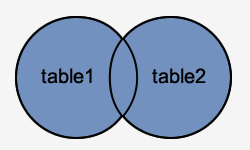FULL OUTER JOIN
Another type of join is called a SQL Server FULL OUTER JOIN. This type of join returns all rows from the LEFT-hand table and RIGHT-hand table with nulls in place where the join condition is not met.
Syntax
The syntax for the FULL OUTER JOIN in SQL Server (Transact-SQL) is:
SELECT columns
FROM table1
FULL [OUTER] JOIN table2
ON table1.column = table2.column;
In some databases, the FULL OUTER JOIN keywords are replaced with FULL JOIN.
Visual Illustration
In this visual diagram, the SQL Server FULL OUTER JOIN returns the shaded area:

The SQL Server FULL OUTER JOIN would return the all records from bothtable1_and_table2.
Example
Here is an example of a FULL OUTER JOIN in SQL Server (Transact-SQL):
SELECT suppliers.supplier_id, suppliers.supplier_name, orders.order_date
FROM suppliers
FULL OUTER JOIN orders
ON suppliers.supplier_id = orders.supplier_id;
This FULL OUTER JOIN example would return all rows from the suppliers table and all rows from the orders table and whenever the join condition is not met, <nulls> would be extended to those fields in the result set.
If a supplier_id value in the suppliers table does not exist in the orders table, all fields in the orders table will display as <null_>_in the result set. If a supplier_id value in the orders table does not exist in the suppliers table, all fields in the suppliers table will display as <null> in the result set.
Let's look at some data to explain how FULL OUTER JOINS work:
We have a table called_suppliers_with two fields (supplier_id and supplier_name). It contains the following data:
| supplier_id | supplier_name |
|---|---|
| 10000 | IBM |
| 10001 | Hewlett Packard |
| 10002 | Microsoft |
| 10003 | NVIDIA |
We have a second table called_orders_with three fields (order_id, supplier_id, and order_date). It contains the following data:
| order_id | supplier_id | order_date |
|---|---|---|
| 500125 | 10000 | 2013/08/12 |
| 500126 | 10001 | 2013/08/13 |
| 500127 | 10004 | 2013/08/14 |
If we run the SELECT statement (that contains a FULL OUTER JOIN) below:
SELECT suppliers.supplier_id, suppliers.supplier_name, orders.order_date
FROM suppliers
FULL OUTER JOIN orders
ON suppliers.supplier_id = orders.supplier_id;
Our result set would look like this:
| supplier_id | supplier_name | order_date |
|---|---|---|
| 10000 | IBM | 2013/08/12 |
| 10001 | Hewlett Packard | 2013/08/13 |
| 10002 | Microsoft | <null> |
| 10003 | NVIDIA | <null> |
| <null> | <null> | 2013/08/14 |
The rows for_Microsoft_and_NVIDIA_would be included because a FULL OUTER JOIN was used. However, you will notice that the order_date field for those records contains a <null> value.
The row for supplier_id 10004 would be also included because a FULL OUTER JOIN was used. However, you will notice that the supplier_id and supplier_name field for those records contain a <null> value.